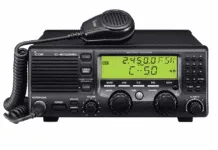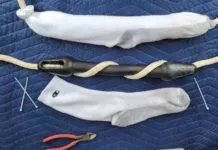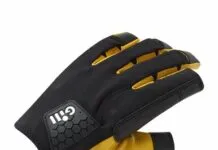[Updated February 27, 2018]
The primary purpose of the safety harness tether, the vital link between you and the boat, is to keep the wearer aboard, not dragging alongside or hydroplaning astern.

Practical Sailor tested 15 tethers in offshore conditions, during both day and night sailing. The tethers came in different lengths, configurations, and utilized different hardware. Unfortunately, we weren’t able to evaluate several new tethers that West Marine sent us (see “Coming Soon to a West Near You,” right) because they arrived after the test was completed. However, we plan to test the new products soon and will report the findings in a later article.
How We Tested
Experienced crew, both men and women, contributed their observations and comments. When creating the table of final results, testers combined tether ease of use, security, construction, and quality into one rating.
After extensive on-the-water testing,
Practical Sailor testers crafted a list of criteria for the ideal tether. It should incorporate a quick-release snap shackle at the inboard end with a lanyard long enough so the wearer can easily release the snap shackle under load. The tether should be just long enough for the wearer to reach the rail should he fall overboard. Practical Sailor found 6 feet to be the longest practical tether length. Tethers with elastic allowing them to contract when not under load are preferable. The “boat end” of the tether should have a non-magnetic, locking snap hook that can be opened with one hand.
A quick-release snap shackle at the harness end of a tether is especially important in case the wearer becomes trapped under an inverted boat (as happened in the 1998 Sydney-Hobart Race) or in a tight spot, like on the wrong side of a jib sheet. The quick-release shackle at the harness end has the added benefit of allowing the wearer to go below before unhooking, leaving the tether clipped on deck and dangling down the companionway or hatch, to be easily reconnected before the sailor returns topside. The harness end quick release also allows crewmates to swap tethers when swapping positions. Quick-release shackle lanyards should never have loops, which could inadvertently snag and open the shackle.
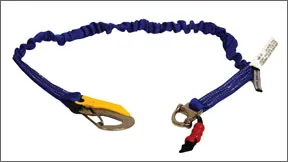
The ability of tethers with integrated elastic to retract helps keep the tether out from underfoot and free of entanglements with winch handles, engine controls, and deck gear. It is also easier to comfortably wrap these elastic tethers around your waist or over your shoulder when theyre not in use.
Tether stitching ideally should be bar-tacked in a repeated zigzag pattern. The thread color should be different from the tether color to allow for easy visual inspection of the stitchings integrity. Faded or damaged webbing or stitching indicates loss of strength and that the tether should be retired.
Some tethers have overload indicators built in. These indicators consist of a colored flag embedded in the tether stitching. In theory, when the tether reaches its overload limit a level of stress that compromises its integrity as a safety device the flag is revealed. And although testers like the concept of the overload indicator, we wouldn’t rely on it to let us know when to retire a tether
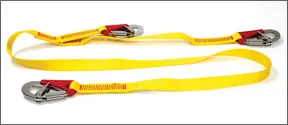
The indicators do not take the place of visual inspection. None of the tethers tested have embedded flags, but the 2007 West Marine models will feature the indicators.
For the boat end of the tether, Gibb and Wichard both make high-quality locking snap hooks. Harness tethers with spring-loaded snap hooks or carabiners instead of locking hardware can be highly dangerous because of their tendency to inadvertently open when hooked to a padeye, eyebolt, stanchion base, or other fixed attachment point. (See “Hook, Line, and Danger,” right.) Practical Sailor testers preferred the Wichard locking snap hook over the Gibb because the latter had the occasional tendency to foul when jackline webbing slipped into or beyond the locking gate when tension was not kept on the tether.
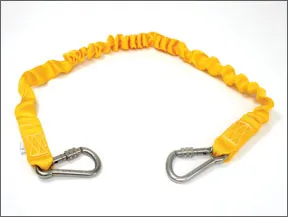
Beyond these basics, it is a personal decision as to which configuration of tether is best suited for the job. Some prefer three-point tethers with one long and one short leg. The advantage of this style is being able to stay hooked to the boat while moving one leg of the tether. The disadvantage of three-point tethers is their extra weight, complexity, and potential tangles. We examined all of the major types for our tether comparison.
West Marine Elastic with Wichard Hook
This 6-foot blue tether (Model 7810724) conveniently contracts to 3 feet, 9 inches when not under load. At the tethers inboard end is a quick-release snap shackle with a 3-inch lanyard covered with four plastic beads that are easy to grip and prevent the lanyard from snagging. At the boat end of the tether is the patented Wichard locking safety hook that you must squeeze from both sides to open. The Wichard hook takes some practice and a strong grip to use quickly. The hardware is attached via stitched loops with 5 inches of stitching.
Bottom Line:
This tether has a hefty price tag ($125), but Practical Sailor considers it to be the current state-of-the-art tether and our Best Choice among the test products.
West Marine with Wichard Hook
This tether, Model 7810716, is identical to Wests elastic tether described previously same color, length, hardware, and stitching however, it does not have the retracting elastic.
Bottom Line:
Practical Sailor would pass on this tether and spend the additional $30 for the benefits of elastic. But for the money, its a quality tether and garnered the PS Budget Buy.
West Marine with Gibb Hook
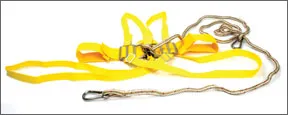
This product (Model 7810682) also lacks the elastic advantages. The 6-foot blue tether has a quick-release snap shackle at the harness end and a Gibb locking safety hook at the boat end.
Bottom Line:
This tether is recommended by Mahina Tiare Expeditions the offshore sailing school taught by bluewater veterans John Neal and Amanda Swan Neal and we recommend it as well.
West Marine with Snap Hook
This relatively inexpensive tether (Model 7810674) at first glance appears to provide everything necessary in a functional tether. Its 6 feet long and has a quick-release snap shackle at the inboard end. However, it lacks elastic, and most importantly, it has a spring-loaded snap hook (carabiner) at the boat end. As highlighted in the story “Hook, Line, and Danger” at left, this non-locking snap hook has a tendency to detach itself.
Bottom Line:
PS does not recommend this tether. The dangers of spring-loaded snap hooks have been commonly known for 20 years, and PS believes all spring-loaded snap hooks without locking devices should be eliminated from use in safety harness tethers.
West Marine Childs
This 6-foot, non-elastic blue tether (Model 315780) has a sewn loop at the inboard end and an asymmetrical spring-loaded snap hook at the boat end. This snap hook can open accidentally not what we would trust on our children.
Bottom Line:
Even the West Marine catalog product advisor, in describing the snap hook, laconically suggests “Not our favorite.” Parents beware.
Sospenders Double with Snap Hook
This tether, like the West Marine tethers, is made by safety equipment giant Stearns Inc. It has the exact same characteristics as the West Marine Model 7810674, except that it has two legs, one 6 feet long and one 3 feet long.
Bottom Line:
Again, the spring-loaded snap hook is an unreliable choice for a safety tether, in our opinion.
Plastimo Elastic with Screw Locks
This 6-foot, yellow elastic tether (Model 31564) has a carabiner with a screw-gate lock at each end. There is no quick release at the inboard end.

Although this style of carabiner is favored by climbers and can be secured with one hand,
PS found the screw-lock difficult to use with cold, numb, and water-softened fingers. At night, despite humming the old mnemonic axiom “lefty-loosey, righty-tighty,” PS evaluators needed a flashlight to determine the correct way to screw/unscrew the locking gate when the carabiner was upside down on the jackline.
On a more painful note, the same carabiners have press-fitted eyelets through which the webbing is secured. The rims of these eyelets are very sharp, and rendered testers fingers sliced and bleeding.
Bottom Line:
The only positive of this tether is its elasticity. And that does not balance its lack of a quick-release hook and its less-than-user-friendly screw gate.
Plastimo with Screw Locks
Similar to the 31564, sans the elastic, Model 31561 has the same carabiner-style hooks at each end that require screwing shut. It is 6 feet long and yellow with white stitching. While having contrasting stitching and tether colors is ideal for inspecting the tethers integrity, the use of white thread on yellow webbing is less effective than red stitching on a yellow tether or even white on a blue tether because the white thread is not as visible against the yellow.
Bottom Line:
The screw-gate hooks are not preferable.
Plastimo Double with Screw Locks
This double tether (Model 31563) has a 6-foot leg and a 3-foot leg with three screw-gate carabiners as locking safety hooks. Testers noted the same white thread on yellow webbing problem as mentioned previously.
Bottom Line:
This tether, like the other Plastimos with screw locks, needs some improvements before we can recommend it.
Plastimo Elastic with Gibb Hooks
This 6-foot elastic tether (Model 40153) has locking Gibb snap hooks at both ends. It cannot be released quickly when under strain. The yellow tether has 3.5 inches of red stitching, which contrasts well to the webbing.
Bottom Line:
Although testers prefer Wichard hardware, which is easier to release under strain, this is a quality tether that we recommend.
Plastimo with Gibb Hooks
This is Model 40152, a non-elastic version of the 40153.
Bottom Line:
As with the West Marine tethers, we recommend spending the extra $20 for an elastic tether.
Plastimo Double with Gibb Hooks
This double tether (Model 40154) has a 3-foot and a 6-foot leg. Having three identical Gibb snap hooks, the tether was somewhat confusing, especially at night. Testers found it difficult to quickly identify which was the body end of the tether and which were the boat ends (legs) of the tether.
Bottom Line:
This tether lacks elastic, but its a step up from the 31563, as its Gibb hooks are improvements over the screw-locking carabiners. The manufacturer should clearly mark the body end of the tether. In the meantime, users would do well to mark the body end with tape or a permanent marker for quick identification.
Jim-Buoy 80-Inch
This tether is made of half-inch braided nylon line with a spliced and stitched loop at both ends, where there are also spring-loaded snap hooks. During testing, these snap hooks did not always spring closed as intended. Their sharp gate tended to snag the tether braid or jackline. The snap hooks can be removed (and potentially lost) from the tether, and can accidentally become detached from padeyes and eye bolts.
Bottom Line:
At 80 inches, this tether is too long for safe use, in our opinion. It is our view that the inferior hardware seriously compromises its use as a life-saving aid.
Jim-Buoy Double
This 10-foot rope tether is identical to the Jim-Buoy single tether, except its 40 inches longer and has a third snap hook tied part way up the tether.
Bottom Line:
We would not trust our lives to this tether.
Jim-Buoy Childs
This tether is black, quarter-inch polypropylene line with a non-locking, spring-loaded snap hook at the boat end. Curious as to the tethers strength,
PS testers attached a 35-pound weight to it and dropped the weight 3 feet, easily snapping the polypro line. In a follow-up, testers attached a 50-pound weight to the tether and dropped it two feet; the line again broke.
Bottom Line:
PS does not recommend using this tether as a safety device (see photo).
Conclusion
Its unfortunate that some manufacturers continue to use the non-locking, spring-loaded snap hooks in their tether designs. The hooks tendency to open accidentally makes them very unsafe, in our opinion, and there are numerous alternatives to their use. Its high time tethers makers stop using these potentially dangerous clips.
Of the tethers we evaluated that met testers standards, our favorite is the West Marine elastic tether with a locking Wichard safety hook. The tether has the features testers find imperative in a safety tether: It contracts; its 6 feet long; it has a quick-release snap shackle with a lanyard and a locking safety hook. The tether lacks an overload indicator, but West Marines new, similar tethers have these embedded flags, and testers preliminary evaluations of these tethers are encouraging. We look forward to field testing them and letting you know how they hold up compared to the tethers reported on here.






